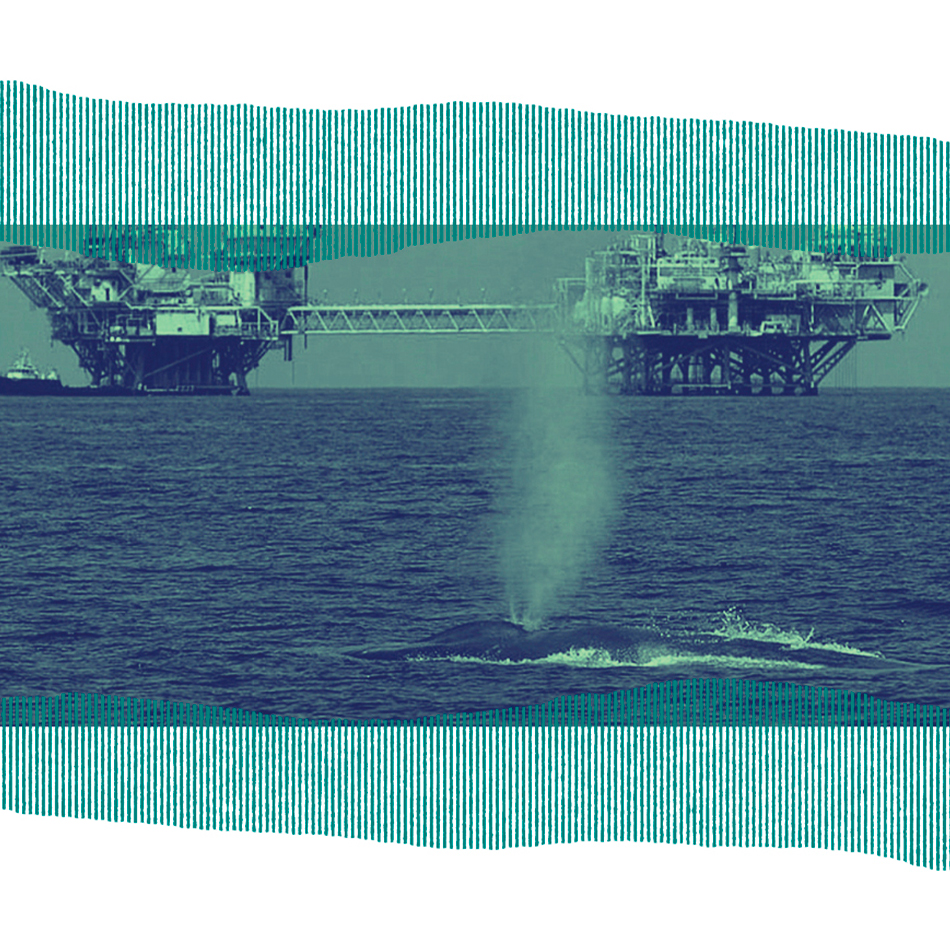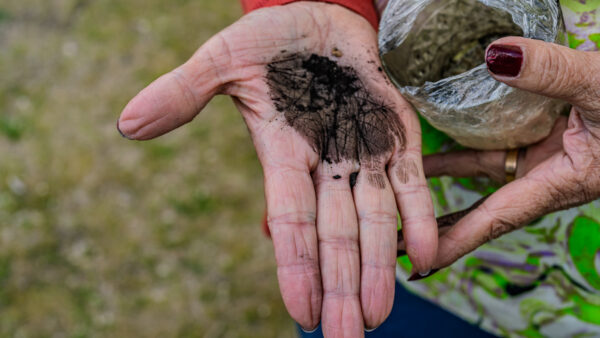By Víctor Quilaqueo y Hernán Scandizzo* of OPSur / Translated by Territorio de Ideas.
In the last days of December 2021, Argentina’s Ministry of Environment authorized a seismic survey campaign in the blocks 100, 108, and 114 in the Northern Argentine Basin, at around 300 kilometers off the coast of Buenos Aires. The government’s decision spurred a widespread rejection, expressed in the streets of the coastal town of Mar del Plata and other cities in the country. The protests continued throughout the summer and are repeated on the 4th of every month since then(1). This ongoing process, which received the name “Atlanticazo”, is an indicator of the growth of the socio-environmental movement in Argentina, and has enough force to defy a set of policies which are oblivious of any grietas(2), such as the promotion of extreme energies.

Foto: Asamblea por un Mar Libre de petroleras – Mar del Plata
While Frente de Todos and Juntos por el Cambio are trying to make their differences clear, there are—at least in the energy sector—several lines of continuity and co-governance (3). Actually, between April and August of 2022, an agenda born out of common resolutions across the political landscape was consolidated. In such a short time, as the socio-environmental movement was becoming more robust, oil companies were gaining a footing at sea; measures taken benefited Equinor, Shell, and the state-run YPF. The national government granted an extension for the exploration phase in the Northern Argentine Basin, and the Secretariat of Climate Change, a dependency of the Ministry of the Environment, approved the additional studies presented by Equinor for blocks CAN 100, 108, and 114. It also considered the environmental assessment declaration as being completed. The additional studies were requested by the Court to decide on three amparo constitutional actions that had been filed to halt the seismic survey. The Executive cleared the way. The seismic acquisition only depends on a legal action deciding its start.
Hydrocarbon production from tight and ultra-deep water reservoirs is promoted by the government and business sectors as the way to achieve fossil fuel self-sufficiency, sovereignty, energy security and productive development, and towards energy transition, while the risks and impacts are disregarded. Our aim in this article is to review the paths extreme energies have taken in Argentina, pointing out the contending speeches and defying the idea that the exploitation of ultra-deep water reservoirs is a way to achieve energy transition.
Extreme debates in the new frontier
Faced with the depletion of conventional hydrocarbon reservoirs—that is, easily recoverable gas and oil—and with geopolitical disputes over energy control, in the last couple of decades governments and energy sector companies became increasingly interested in ultra-heavy crude oil, tar sands, tight and shale formations, and ultra-deep water reservoirs. Their development and commercial exploitation heralded a new fossil golden age. However, exploiting unconventional sources is more complex and presents various technological and financial challenges, plus environmental and labor-related risks. For these reasons, the US American professor and writer Michael T. Clare calls them “extreme energies”. The concept was taken and further developed by the Global South network Oilwatch Latin America to try to pin down the current stage of the fossil era.
Extreme energies became embedded in the energy debate in Argentina at least a decade ago, with the massive application of hydraulic fracturing or fracking in tight and shale formations (such as Vaca Muerta). Their relevance gains currency once again with the new exploration projects in ultra-deep waters. In both moments, the promotion of unconventional hydrocarbons spurred rejection, albeit for different reasons.
In 2013, mobilizing efforts against their exploitation in the southern provinces of Neuquén and Río Negro drew from at least four strands(4). One was founded on the socio-environmental perspective and rejected the prolonged dependency on fossil fuels, centering the disputes around water defense. In close relation, the Mapuce people challenged the intensification of territorial damage and contamination (to which they were already exposed through conventional hydrocarbon activities). They also pointed at the lack of prior, free, and informed consent and the violation of other collective rights. A third perspective, the so-called “national-popular”, was critical of the strategic alliance between the then recently “recovered” YPF(5) and Chevron to exploit Vaca Muerta. Finally, a left-wing sector also opposed the project, which they identified with a deepening of dependency and plunder. These four strands were not exclusive, but rather converged and fed into each other on occasions.
During the Argentine summer, it wasn’t the presence of a foreign oil company like Equinor, but the offshore activity in ultra-deep waters itself which triggered protests against the approval of the Environmental Impact Study that gave a green light to seismic surveying in the Northern Argentine Basin. The socio-environmental movement invigorated the opposition to the opening up of a new extractive frontier arguing against the continued dependency on fossil fuels, the environmental risks of extreme projects, and the socio-economic and territorial transformations that coastal communities would undergo as a result. Even if this movement was the driver of the mobilizations, the contribution of other strands like conservation organizations and those focusing their critique on the plunder of common goods should not be underestimated.
The protagonism of socio-environmental movements reflects its growth in recent years, as it has been the maker of momentous political events both nationally and regionally, such as the Mendozazo (2019) and Chubutazo (2021)(6). Both these landmarks are not only about struggle, but also about victories that thwarted governability in both provinces through anti-extractivist confrontation. This is the current magnitude of socio-environmental movements. And it is precisely against the background of such disputes that anti-large-scale mining and anti-offshore mobilizations have converged. To the naked eye these could appear to be different struggles, however, the underlying issue is the same—the mode of production and of relation with nature.

Denialism and business
Government narratives have attempted to infantilize the massive opposition and their reasons(7), to the extent that officials from the Argentine Ministry of Energy labeled the arguments presented by environmentalist groups as fake news. Lack of in-depth discussion across the government is evident. As part of the construction of an agenda around the impacts of the offshore activity, provincial and national authorities, as well as union leaders, have stated that in Argentina ultra-deep water oil and gas is a safe bet, with low to no risk. These groups try to limit the debate to whether the platforms will be seen from the shore and whether there will be an oil spill or not. They dismiss the risk on the grounds of the country’s long experience working with offshore oil recovery that dates back to the 1930s. What they are not saying is that those wells, drilled off the coast of Comodoro Rivadavia city, could be easily accessed from the shore when the tide was low. Neither are they mentioning the differences between the Southern Sea Basin, where wells are less than 100 meters deep (as measured from water level to seabed) and those projected on the Northern Argentine Basin, where depths will go from 1,700 to 4,000 meters.
Unlike in the last decade, when the official narrative simply ignored the environmental agenda, some actors who promote expanding the frontier towards ultra-deep water reservoirs now argue in favor of recovering gas not only to ensure self-sufficiency, but also to move towards energy transition, i.e. to replace other fossil fuels with gas. As for this argument, it should be noted that, besides being controversial (there have been many studies that question this), promoting natural gas as a bridge fuel to decarbonize the energy mix is a change already underway in Argentina.
Since the discovery of the mega-reservoir Loma La Lata in Neuquén, in the late 1970s, gas has had a larger share in the energy mix. It currently accounts for 55 percent of primary sources, while crude oil accounts for around 29 percent. If the country is to “clean” its energy mix, not only does it need to reduce the use of crude oil, but it also needs to reduce the use of gas and replace it with electricity from renewable sources. In order to do so, priorities should focus on investments in renewable generation as well as in electricity transmission infrastructure, as advised by the Observatorio de Energía y Sustentabilidad – UTN FRRo.
On the other hand, the energy transition proposal based on favoring gas use over other fossil fuels ignores the recommendations made by the United Nations Committee on Economic, Social and Cultural Rights, which asked the Argentine government to “reconsider the large-scale exploitation of unconventional fossil fuels through hydraulic fracturing in the Vaca Muerta region” in order to ensure compliance with climate commitments. It also ignores the warning issued by the International Energy Agency, which noted that, to achieve the climate goals under the Paris Agreement, no new extractive frontiers should be opened.
Priorities
While environmental demands are disregarded as second-class, there is an imposition of the macroeconomic perspective, which advances over the new frontier and fuels new chimeras of El Dorado—or at least of the possibility of generating currency to pay the IMF an illegitimate debt. At the national level, when gas is presented as a bridge fuel, the ultimate goal is not the decarbonization of the Argentine energy matrix, but the market niches opened up by the energy transition in the Global North. Argentina is to be inserted as a provider of liquefied natural gas (LNG) and blue hydrogen; the latter obtained from methane through carbon capture in the production process. With the abandonment of fossil fuels in the horizon as a goal to slow down global warming, Argentinian authorities are seeking a fast monetization of the hydrocarbon potential before this market is contracted(8).
The extractivist advance in search of gas and oil reservoirs in ultra-deep waters is a new stage in the promotion of extreme energies in Argentina. As it happened in 2012 and 2013 with unconventional reservoirs and fracking, the recent attempts to deepen the fossil energy mix have spurred protests to reject these policies. However, unlike a decade ago, today the socio-environmental movement not only has the strength to defy the energy mix—as proved by the Atlanticazo—but also the power to stop projects and revert governmental decisions, as was the case in Mendoza and Chubut. Although some sectors of the national government are presenting green development proposals, in contrast to the fracking experience a decade ago, these serve the attempts of presenting extreme energies as a leverage to the energy transition. One should ask, if the political parties in power continue to ignore these demands, if there are no real policies implemented, but just cosmetic ones, how much more tension can the environmental rope withstand?
* This article is part of a new dossier Research Collective on Socio-Environmental Crisis and Dispossession of Tricontinental: Institute for Social, which addresses public debates on the offshore seismic survey project on the Atlantic coast of Buenos Aires province, and includes an appraisal of its social and environmental costs vs. its potential economic benefits. All the contributions to this dossier, with their similar or differing views, are meant to help us think and build alternatives from a grassroots perspective.
Article published in Spanish on https://opsur.org.ar/petroleras-en-el-mar-la-transicion-energetica-como-bandera-del-extractivismo/
(1) The calendar emerged from the fight against large-scale mining in Esquel—where, since December 4th, 2002, people protest under the slogan “No to the Mine” the 4th of every month—was thus resumed.
(2) TN: In Argentina’s political context, the word grieta (crack, fissure) is mainly used to express a deep political polarization between the people, tied to big political differences between Peronism (Frente de Todos) and right-wing parties such as Juntos por el Cambio.
(3) The licensing round of the continental shelf blocks in 2017, under Mauricio Macri’s administration, was possible after the submission made by Argentina in 2009 before the UN’s Commission on the Limits of the Continental Shelf, during Cristina Fernández’ first mandate; and the activity’s regulatory framework is the National Hydrocarbons Law, amended in 2014 at the request of the national executive power.
(4) In Entre Ríos, fracking opposition after YPF’s announcement of an exploration campaign had a largely socio-environmental quality (the defense of the Guaraní aquifer). Protests led to a ban against fracking in the province. In Mendoza and Chubut, mobilizations were centered around water defense and the territorial rights of indigenous communities.
(5) Translator’s note: refers to the partial renationalization of the state-run oil company YPF in 2012, from its previous majority owner, the Spanish Repsol.
(6) TN: grassroots, assembly-driven mobilizations in the provinces of Mendoza and Chubut, against the modification of a law protecting water from large mining corporations, and against a zoning law for large-scale mining respectively.
(7) Those narratives remind us of the way some sectors used to refer to feminist demands when they were not a priority in the public agenda and were considered as secondary, petty-bourgeois demands.
(8) We recommend Gustavo Lahoud’s article “Pujas que la transición energética no disuelve” (available in Spanish).




